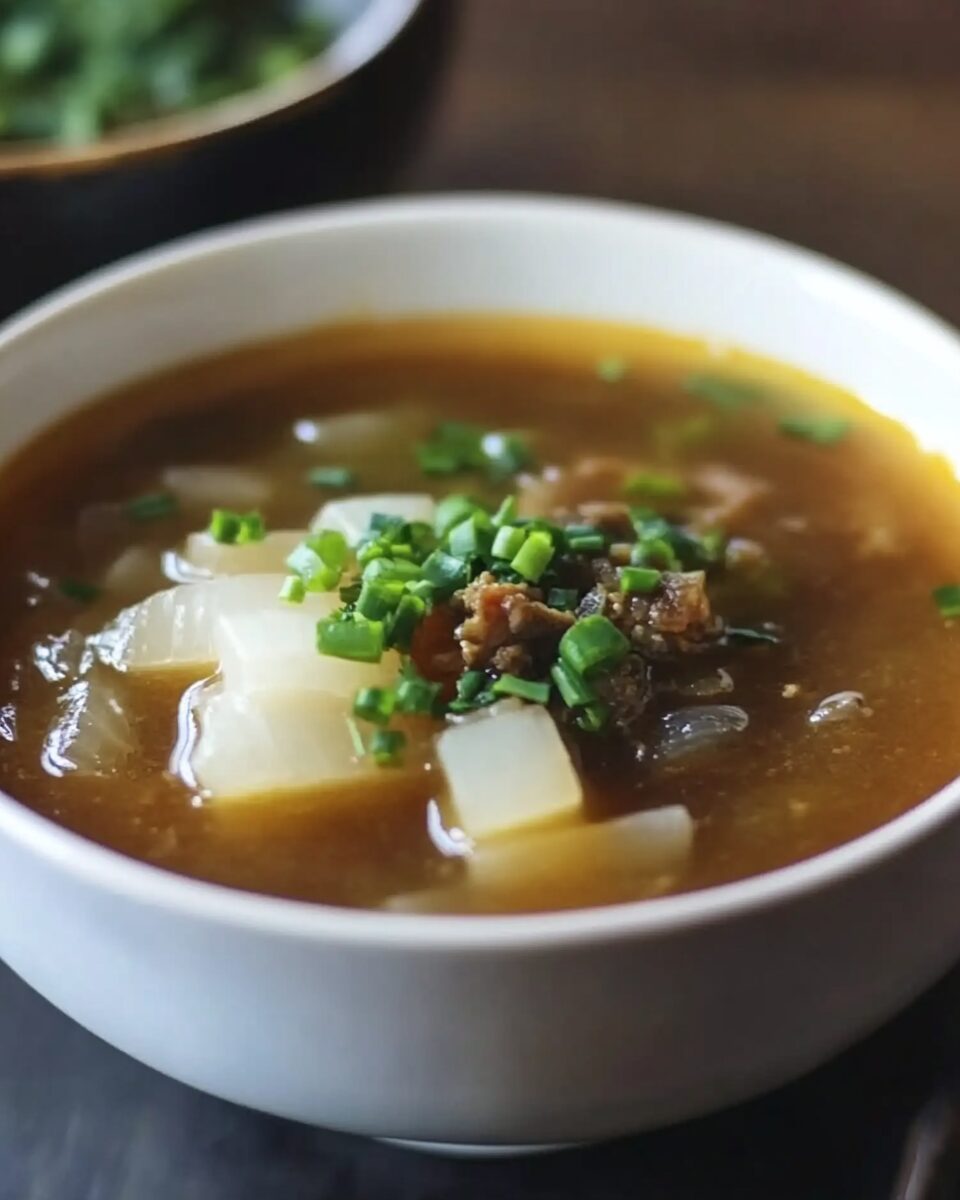Japanese Onion Soup is a traditional appetizer served in many Japanese restaurants. It’s a light and flavorful broth-based soup that combines the subtle sweetness of onions with the umami depth of mushrooms and a hint of ginger. This soup is known for its clear broth and delicate flavors, making it a perfect start to any meal.
Full Recipe:
Ingredients
- ½ stalk celery, chopped
- 1 small onion, chopped
- ½ carrot, chopped
- 1 teaspoon grated fresh ginger root
- ¼ teaspoon minced fresh garlic
- 2 tablespoons chicken stock
- 3 teaspoons beef bouillon granules
- 1 cup chopped fresh shiitake mushrooms
- 2 quarts water
- 1 cup baby portobello mushrooms, sliced
- 1 tablespoon minced fresh chives
Directions
-
In a large saucepan or stockpot, combine the celery, onion, carrot, ginger, garlic, and a few of the mushrooms. Add chicken stock, beef bouillon, and water. Place the pot over high heat and bring to a rolling boil. Once boiling, cover, reduce heat to medium, and cook for 45 minutes.
-
Place all of the remaining mushrooms into a separate pot. When the boiling mixture is done, place a strainer over the pot with the mushrooms in it. Strain the cooked soup into the pot with the mushrooms, discarding the solids.
-
Serve the broth with mushrooms in small bowls, garnished with fresh chives.
Nutritional Facts
Per serving (6 servings total):
- Calories: 25
- Total Fat: 0g
- Saturated Fat: 0g
- Cholesterol: 0mg
- Sodium: 258mg
- Total Carbohydrate: 4g
- Dietary Fiber: 1g
- Total Sugars: 2g
- Protein: 1g
- Vitamin C: 2mg
- Calcium: 18mg
- Iron: 1mg
- Potassium: 135mg
Cultural Significance and Origins
Japanese Onion Soup, although relatively simple in preparation, is rooted in a broader culinary tradition that emphasizes the harmony of ingredients. The use of dashi—a broth made from kombu (seaweed) and katsuobushi (bonito flakes)—is central to Japanese cooking, serving as the foundation for countless soups and sauces. This soup’s connection to dashi underscores its authenticity and the importance of umami in Japanese taste profiles.
The clear soup is often associated with teppanyaki-style dining, where it is served as a first course in Japanese steakhouses around the world. In this setting, it acts as a palate awakener, preparing the guest for the multi-course experience to follow. However, the concept of clear broth soups predates modern restaurant culture and is deeply embedded in Japanese home cooking and temple cuisine, where minimalism and natural flavors are emphasized.
Flavor Profile and Aromatics
One of the most defining aspects of Japanese Onion Soup is its clean yet deeply savory flavor. Unlike Western onion soups that rely heavily on butter, cheese, or thickened bases, this version is light, clear, and designed to highlight the natural sweetness of onions rather than mask it.
The broth’s depth typically comes from a slow simmering process involving aromatics like carrots, celery, and garlic in combination with the onion. The result is a golden, translucent soup with an earthy aroma and nuanced taste. The addition of soy sauce or tamari adds saltiness and umami, while optional touches like mirin can introduce a mild sweetness.
Mushrooms such as shiitake are often added, bringing another layer of umami as well as texture. These ingredients are not just functional—they are part of the sensory experience. The steam that rises from a freshly served bowl, the gentle swirls of green onion garnish, and the occasional mushroom floating atop are all intended to create a serene, almost meditative moment.
Health Benefits and Nutritional Value
Japanese Onion Soup isn’t just pleasing to the palate—it also boasts a range of health benefits. The dish is low in calories and fat, making it a suitable choice for those watching their intake or following a light meal plan. Because the soup is typically not thickened with dairy or flour, it’s also suitable for those who are lactose intolerant or gluten-sensitive, especially when using gluten-free soy sauce.
Onions themselves are a rich source of antioxidants, particularly quercetin, which has anti-inflammatory and heart health benefits. When simmered slowly, onions release their natural sugars, providing sweetness without the need for added sugar or artificial flavoring. Garlic, often used in the base, contributes immune-boosting properties, while mushrooms add a healthy dose of B-vitamins and essential minerals.
Because the soup is hydrating and warming, it is often consumed during colder months or when someone is feeling under the weather. Its clear consistency makes it easy to digest, making it an ideal option for those recovering from illness or seeking a gentle start to a multi-course meal.
Modern Variations and Creative Twists
Though rooted in tradition, Japanese Onion Soup has seen its fair share of modern interpretations. Some chefs infuse the broth with additional herbs such as lemongrass or ginger for a fusion twist. Others experiment with different mushroom varieties like enoki or maitake to alter the texture and depth of flavor.
In vegetarian or vegan variations, dashi can be made solely from kombu and dried shiitake mushrooms, eliminating the need for bonito flakes. This not only respects dietary restrictions but also maintains the integrity of the umami flavor that is so central to the dish.
For those seeking a heartier version, thin slices of tofu, slivers of carrot, or even noodles can be added. However, the essence of the dish—its clarity, simplicity, and elegance—should always remain intact. It’s this delicate balance that allows for innovation without losing the core identity of the soup.
Pairing and Presentation
Presentation plays a significant role in Japanese culinary aesthetics, and Japanese Onion Soup is no exception. It is traditionally served in small lacquered bowls, often black or deep red, which helps to emphasize the golden clarity of the broth and the vibrant green of the scallions. A well-presented bowl of soup is as much a visual delight as it is a gustatory one.
In terms of pairing, the soup is often served as a prelude to grilled meats or seafood. Its lightness contrasts beautifully with the richness of teriyaki chicken, grilled steak, or tempura. It also complements sushi or sashimi dishes, acting as a warm counterpoint to the coolness of raw fish.
Beverage pairings may include green tea, sake, or a light Japanese beer. The soup’s gentle flavor allows it to pair well with a variety of drinks without overwhelming the palate.
Why It Appeals Across Cultures
Japanese Onion Soup has found its way into restaurants and homes far beyond Japan’s borders. Its broad appeal lies in its simplicity, health benefits, and ability to fit seamlessly into a variety of dietary needs. In Western contexts, it’s often introduced through Japanese steakhouses, where diners come to expect it as a familiar and comforting first course.
Beyond the restaurant scene, more people are attempting to recreate this dish at home due to the rise in popularity of Japanese cuisine and increased interest in healthy cooking. Its ease of preparation, minimal ingredients, and adaptability make it an accessible entry point for those unfamiliar with Japanese cooking techniques.
Moreover, the universal appeal of onions—an ingredient found in nearly every culinary tradition—makes the soup feel familiar, even if it’s being experienced for the first time. The emotional comfort associated with warm broths and the clean taste of slow-cooked vegetables transcends borders.
Tips for Perfecting Your Japanese Onion Soup
To achieve the best results when preparing this soup at home, several tips can elevate the final dish. First and foremost, patience is key. Allowing the onions to slowly caramelize brings out their natural sweetness and deepens the flavor of the broth. Rushing this process can result in a bland or overly sharp soup.
Using high-quality ingredients is equally important. Since the soup relies on few components, each one must shine. Opt for organic onions, fresh scallions, and high-quality soy sauce. If using dashi, prepare it from scratch using kombu and bonito flakes for the most authentic and robust flavor.
Straining the broth after simmering ensures clarity—a hallmark of Japanese Onion Soup. This step also refines the texture and enhances presentation. Finally, garnishing just before serving preserves the freshness and color of ingredients like scallions or mushrooms.
Conclusion: The Quiet Brilliance of a Simple Bowl
Japanese Onion Soup may not boast the flamboyance of ramen or the complexity of hot pot, but it exemplifies a different kind of brilliance—one that lies in restraint, purity, and intentionality. Each element is thoughtfully chosen, every flavor delicately balanced, and the result is a soup that feels both humble and transcendent. In a world where food often competes to be the boldest or most extravagant, Japanese Onion Soup offers a moment of quiet clarity. It reminds us that culinary excellence doesn’t always come from complexity, but from the art of doing simple things exceptionally well.






